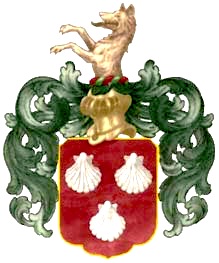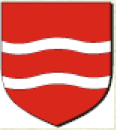Anders
Ulf (Wolf) Family
Jutland
peninsula, Denmark
Anders Ulf (Wolf)
b. about 1410 perhaps born in Holstein (southern Jutland
peninsula)
lived Fogedgården, Vadum, Kjaer herred, Jutland peninsula,
Denmark
d. 1450/58, Fogedgården, Vadum, Kjaer herred, Denmark #

There is some evidence that this
implied royalty is not in the normal definition although
the family held important community positions.
m. Anne Madsdatter of Orning
, Denmark # [LDS mar.]
b. about 1440 Jutland peninsula, Denmark
d. ? Denmark

Orning Shield
her father: Mads Svendsen
Orning (til Eget) #
(his father was Svend Orning, Counsilor in Aalborg, Den. )
her mother: Anna Roed of Vorstgård#
his father: unknown
his mother: unknown
#Records of the Roskilde Cathedral, 2020
The research here has been created by the Kjaerulf family
researchers over the years. My records are interconnected and the
actual historical records are developed here briefly. The
quote below give some credence to the source of the name and is in
the location of my "Skipper Clement" family.
The name is spelled in at least five different ways.
"The Kjærulff family history
goes back to approx. 1400.
The first Kjærulf is
considered to be the farmer Anders Wulff. Around 1400 he came
from Holsten in Northern Germany and settled in the Kjær
Herred (District) in the village Vadum in Northern Jutland,
Denmark. He became the chief of police for Kjær Herred. From
the farm of "Fogedgaard" Kjærulfs kept holding the position of
chiefs of police for almost 300 years until 1684."
[Kjaerulf family - web site] [ Klitgaard p.7]
The family crest includes a wolf's profile which refers
back to Kjaer and wolf. Kjaer refers to a swamp or marsh implying
a "swamp fox", or "forest rabbit" . Spelling vary widely: "Kerul,
Kerull, Keruld, Kierul, Kieruel, Kieruld, Kierull, Kierulf,
Kierulff, Kjeurlf, Kjerulff, Kjaerulf, Kjaerulff, Kjaerulf,
Kjaerulff, Kaerulf, Kaerulf, Kaerulf, Kjaerulv, Kjerrulf, etc."
Even the original farm name is similar known as Cherool.
Hillerød 27
"The majority of the Norwegian noble
families were probably not much above the free farmers
among who they lived, and only few of them were
sufficiently wealthy to travel to foreign countries to
obtain advanced education beyond what was available at
home, and by 1648 some of these families nobility seems to
have been forgotten." [Klitgaard p3-4]
Wikipedia of Denmark selected this
passage of Adam of Bremen. (translated by google.com)
In 1075 Adam wrote of
Bremen as follows about Jutland and Vendsyssel::
"The land of Denmark is
almost entirely submerged in islands. The first part of
Denmark, called Jylland (Jutland), stretches from the
Eider in the longitude to the north and measures 3 day
trips if you turn off to Funen, but if you leave the
road from Schleswig to Aalborg in the same line, you have 5
or 7 day trips. It is the Emperor Otto Road just up to
Vendsyssel and the outermost sea. The width of Jutland
is quite large at the owner but from there it narrows
down like a tongue to the tip called
Vendsyssel, where it ends Jutland, from which is the
shortest crossing to Norway. All the Germanian lands
abound in deep forests, but Jutland is even more
terrifying than other lands, and is landed due to the
lack of crops to water because of the
assassination of the pirates, it is barely cultivated in
any place and is barely suitable for human settlement.
However, where the heat breaks in, there are very big
cities.
The "nobility" label was probably
used differently in the early days. It seems that
"bailiffs" label may have been almost handed down along
family lines. Carl Klitgaard believes that the
family, if it was noble, perhaps lost their nobility and
became a "free farmer." [p. 4]
Hillerød 27
Dyrskjøt thinks that the
Kjærulfs came from “the Wolffer and Pogwisches1, and he says that the first
Kjærulf man known to him was: “Anders Wlff, also called Anders
Andersøn Wolff,
who owned the farm Aslundgaard2, Fogdegaard3, Bjørum4, and much property and farms
in Kjær, Huetboe and Hann districts .... And had a
grey Wlff in their coat of arms. He lived during
the reigns of kings Erich of Pommern, Christoffer
of Bavaria, and Christian I 1430, 1440, and 1450,
as is reported in old letters. But the Kiervlff
name was given to him by King Erich personally,
since he won in a peculiar case with the court
regarding some Wolf feuds. When he won the case
the king asked him where he lived. When he
answered, I live in Kjær district, the king told
him, you and your offspring will now have the name
Kiervlff." [Klitgaard
p7]
The author's conclusion is that this family was never noble
and had no listing of a coat of arms. If they had been
associated with Clement they did not loose their nobility then but
may have lost their family position and been relegated to a feudal
class farmer. [Klitgaard p7]
Hillerød 27
Anders Ulff or Anders Kjærulf, who is described above.
Son: Anders Andersen
Kjærulf, lived in 1448 in
Fogedgaard in Vadum parish and was bailiff in Kjær
district3. He is also listed in
1450 and 14544, but he probably died
before 1458, since Thord Nielsen both in that year and
in 1460
Hillerød 27
is
listed as bailiff in Kjær district.1 The fact that none of Anders
Kjærulf’s sons became bailiff may lead us to believe
that he died before they came of age. However the
bailiff position was apparently occupied from the
Middle Ages and until the end of the 17th century, when it was filled by
the mentioned Thord Nielsen. We do not know the name
of Anders Kjærulf’s wife. They apparently had at least
three sons, and Dyrskjøt records correctly that
Skipper Klement’s mother was a Kjærulf, so she can
best be placed here. We then get the following
descendants:
A.? N, N,
Andersdaughter Kjærulf, married to Anders N.
N. in Vedsted in
Aaby parish, with whom she besides other children2
had the son Klement
Andersen,
b. 1484.3 He was executed in
1536, became known in history as Skipper
Klement, about whom Dyrskjøt says he betrayed
himself and the Kjærulfs by employing poorly
planned revolutionary methods. Among other well
known persons in this family we must list the
minister in Nakskov Laurids
Mortensen Vedsted (father
of the Thura family and his combative brother Peder
Mortensen Vedsted,
mayor of Nakskov around 1660.
B. Peder
Andersen Kjærulf,
is mentioned by Dyrskjøt 1454, but nothing else is
known about him. Dyrskjøt records that he had two
sons:
1. Anders
Pedersen Kjærulf,
about whom nothing else is known.
2. Bertel
Pedersen Kjærulf,
“was married sins out.”4
Anders Kjærulf in
Raageleje5
may be from this
branch. He got his arrears from the Crown on
April 1, 1586 (1⁄2 barrel of
cod), forgiven because of poor fishing season.6
C. Jens Andersen
Kjærulf, see the Kornumgaard
line.
D. Anders
Andersen Kjærulf is
mentioned by Dyrskjøt 1470. “He owned Aslund,
Fogedgaard and much other
property.” Dyrskjøt does not mention him as
bailiff in Kjær district. However he is recorded
as such in 1485 when after St. Knuds [Klitgaard p8-9]
Source:
Census
records - Dansk Demografisk Database,
http://ddd.dda.dk/
Christoffersen, Kent H. records of, Vestervang 9, Aars 9600,
Denmark +45 98626580 -
(his
mother
was
the primary researcher on this
line) email -
khc@vestervang9.dk
Kjaerulf Family Website.
-- http://www.kiermeet.dk/Kiermeet/
Klitgaard, Carl (1868-1957): "Kjærulffske Studier", in Danish published 1914.
502 pages. in the Viborg Landsarkiv, Håndskriftsamlingen
reg. nr.
H1(10)-5). translated into English by Anders Kjærulff-Knudsen
(living in Hillerød, Denmark) and Erik Karoll - Kjaerulf
Studies.
IN
COMMISSION BY MAGNUS A. SCHULTZ, AALBORG AND CAMMERMEYERS BOOKSHOP,
CHRISTIANIA P. HANSEN's
PRINTING OFFICE, AALBORG 1914 -1918
Hi
Roskilde History and
Genealogy, http://www.roskildehistorie.dk ß
Munk family -
http://www.roskildehistorie.dk/stamtavler/adel/Kierulf
Wikipedia of Denmark in Danish
-----https://da.wikipedia.org/wiki/Vendsyssel
Danish
Farms Index || Elroy's Family
Index || Ancestor Chart
#363






All information and
photos included within these pages was developed by
the help of hundreds of researchers. The information
here is for the express purpose of personal
genealogical research and is freely offered as long as
this site is listed as a source. It may not be
included or used for any commercial purpose or
included in any commercial site without the express
permission of Elroy Christenson. Copyright Elroy
Christenson 1998-2020.
web pages created by Elroy
Christenson-
elroy@next1000.com - last updated 8/07/20







